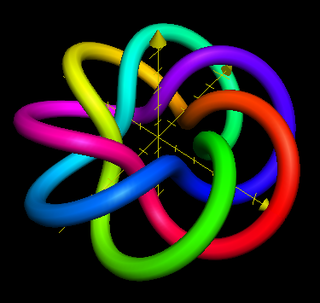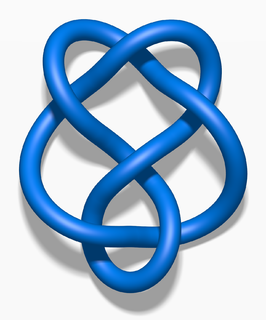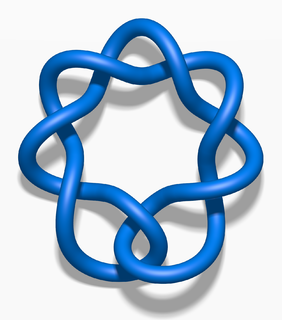
In knot theory, a figure-eight knot is the unique knot with a crossing number of four. This makes it the knot with the third-smallest possible crossing number, after the unknot and the trefoil knot. The figure-eight knot is a prime knot.

In topology, knot theory is the study of mathematical knots. While inspired by knots which appear in daily life, such as those in shoelaces and rope, a mathematical knot differs in that the ends are joined together so that it cannot be undone, the simplest knot being a ring. In mathematical language, a knot is an embedding of a circle in 3-dimensional Euclidean space, . Two mathematical knots are equivalent if one can be transformed into the other via a deformation of upon itself ; these transformations correspond to manipulations of a knotted string that do not involve cutting the string or passing the string through itself.

In knot theory, a branch of mathematics, the trefoil knot is the simplest example of a nontrivial knot. The trefoil can be obtained by joining together the two loose ends of a common overhand knot, resulting in a knotted loop. As the simplest knot, the trefoil is fundamental to the study of mathematical knot theory.
In mathematics, in the subfield of geometric topology, the mapping class group is an important algebraic invariant of a topological space. Briefly, the mapping class group is a certain discrete group corresponding to symmetries of the space.
In the mathematical field of knot theory, the Jones polynomial is a knot polynomial discovered by Vaughan Jones in 1984. Specifically, it is an invariant of an oriented knot or link which assigns to each oriented knot or link a Laurent polynomial in the variable with integer coefficients.

In knot theory, a torus knot is a special kind of knot that lies on the surface of an unknotted torus in R3. Similarly, a torus link is a link which lies on the surface of a torus in the same way. Each torus knot is specified by a pair of coprime integers p and q. A torus link arises if p and q are not coprime. A torus knot is trivial if and only if either p or q is equal to 1 or −1. The simplest nontrivial example is the (2,3)-torus knot, also known as the trefoil knot.

In probability theory, the Rice distribution or Rician distribution is the probability distribution of the magnitude of a circularly-symmetric bivariate normal random variable, possibly with non-zero mean (noncentral). It was named after Stephen O. Rice.

In knot theory, the Whitehead link, named for J. H. C. Whitehead, is one of the most basic links.
In mathematics, Schubert calculus is a branch of algebraic geometry introduced in the nineteenth century by Hermann Schubert, in order to solve various counting problems of projective geometry. It was a precursor of several more modern theories, for example characteristic classes, and in particular its algorithmic aspects are still of current interest. The phrase "Schubert calculus" is sometimes used to mean the enumerative geometry of linear subspaces, roughly equivalent to describing the cohomology ring of Grassmannians, and sometimes used to mean the more general enumerative geometry of nonlinear varieties. Even more generally, “Schubert calculus” is often understood to encompass the study of analogous questions in generalized cohomology theories.
In mathematics, the Stirling polynomials are a family of polynomials that generalize important sequences of numbers appearing in combinatorics and analysis, which are closely related to the Stirling numbers, the Bernoulli numbers, and the generalized Bernoulli polynomials. There are multiple variants of the Stirling polynomial sequence considered below most notably including the Sheffer sequence form of the sequence, , defined characteristically through the special form of its exponential generating function, and the Stirling (convolution) polynomials, , which also satisfy a characteristic ordinary generating function and that are of use in generalizing the Stirling numbers to arbitrary complex-valued inputs. We consider the "convolution polynomial" variant of this sequence and its properties second in the last subsection of the article. Still other variants of the Stirling polynomials are studied in the supplementary links to the articles given in the references.
In 3-dimensional topology, a part of the mathematical field of geometric topology, the Casson invariant is an integer-valued invariant of oriented integral homology 3-spheres, introduced by Andrew Casson.

In knot theory, the cinquefoil knot, also known as Solomon's seal knot or the pentafoil knot, is one of two knots with crossing number five, the other being the three-twist knot. It is listed as the 51 knot in the Alexander-Briggs notation, and can also be described as the (5,2)-torus knot. The cinquefoil is the closed version of the double overhand knot.
In mathematics the Burau representation is a representation of the braid groups, named after and originally studied by the German mathematician Werner Burau during the 1930s. The Burau representation has two common and near-equivalent formulations, the reduced and unreduced Burau representations.

In knot theory, the three-twist knot is the twist knot with three-half twists. It is listed as the 52 knot in the Alexander-Briggs notation, and is one of two knots with crossing number five, the other being the cinquefoil knot.

In knot theory, the stevedore knot is one of three prime knots with crossing number six, the others being the 62 knot and the 63 knot. The stevedore knot is listed as the 61 knot in the Alexander–Briggs notation, and it can also be described as a twist knot with four twists, or as the (5,−1,−1) pretzel knot.

In knot theory, the square knot is a composite knot obtained by taking the connected sum of a trefoil knot with its reflection. It is closely related to the granny knot, which is also a connected sum of two trefoils. Because the trefoil knot is the simplest nontrivial knot, the square knot and the granny knot are the simplest of all composite knots.

In knot theory, the 62 knot is one of three prime knots with crossing number six, the others being the stevedore knot and the 63 knot. This knot is sometimes referred to as the Miller Institute knot, because it appears in the logo of the Miller Institute for Basic Research in Science at the University of California, Berkeley.

In knot theory, a branch of mathematics, a twist knot is a knot obtained by repeatedly twisting a closed loop and then linking the ends together. The twist knots are an infinite family of knots, and are considered the simplest type of knots after the torus knots.

Attempts have been made to describe gauge theories in terms of extended objects such as Wilson loops and holonomies. The loop representation is a quantum hamiltonian representation of gauge theories in terms of loops. The aim of the loop representation in the context of Yang–Mills theories is to avoid the redundancy introduced by Gauss gauge symmetries allowing to work directly in the space of physical states. The idea is well known in the context of lattice Yang–Mills theory. Attempts to explore the continuous loop representation was made by Gambini and Trias for canonical Yang–Mills theory, however there were difficulties as they represented singular objects. As we shall see the loop formalism goes far beyond a simple gauge invariant description, in fact it is the natural geometrical framework to treat gauge theories and quantum gravity in terms of their fundamental physical excitations.
In mathematics, Zolotarev polynomials are polynomials used in approximation theory. They are sometimes used as an alternative to the Chebyshev polynomials where accuracy of approximation near the origin is of less importance. Zolotarev polynomials differ from the Chebyshev polynomials in that two of the coefficients are fixed in advance rather than allowed to take on any value. The Chebyshev polynomials of the first kind are a special case of Zolotarev polynomials. These polynomials were introduced by Russian mathematician Yegor Ivanovich Zolotarev in 1868.


















